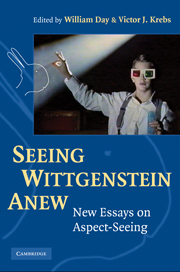Book contents
- Frontmatter
- Contents
- List of Contributors
- Acknowledgments
- Abbreviations of Wittgenstein's Works
- Seeing Wittgenstein Anew
- Introduction: Seeing Aspects in Wittgenstein
- I ASPECTS OF “SEEING-AS”
- 1 Aesthetic Analogies
- 2 Aspects, Sense, and Perception
- 3 An Allegory of Affinities
- 4 The Touch of Words
- II ASPECTS AND THE SELF
- III ASPECTS AND LANGUAGE
- IV ASPECTS AND METHOD
- Appendix: A Page Concordance for Unnumbered Remarks in Philosophical Investigations
- List of Works Cited
- Index
4 - The Touch of Words
Published online by Cambridge University Press: 05 June 2012
- Frontmatter
- Contents
- List of Contributors
- Acknowledgments
- Abbreviations of Wittgenstein's Works
- Seeing Wittgenstein Anew
- Introduction: Seeing Aspects in Wittgenstein
- I ASPECTS OF “SEEING-AS”
- 1 Aesthetic Analogies
- 2 Aspects, Sense, and Perception
- 3 An Allegory of Affinities
- 4 The Touch of Words
- II ASPECTS AND THE SELF
- III ASPECTS AND LANGUAGE
- IV ASPECTS AND METHOD
- Appendix: A Page Concordance for Unnumbered Remarks in Philosophical Investigations
- List of Works Cited
- Index
Summary
Seeing X as Y, or as like Y, is something not everyone with normal eyesight can be expected to do; yet Wittgenstein says that someone may be blind to that aspect of a “given” X. The thoughts to follow here about the idea of seeing (and failing to see) something as something and its associated concepts – Wittgenstein says the idea brings into play “hugely many interrelated phenomena and possible concepts” (PI 199d), which is surely one source of the fascination of this region of the Investigations – were forming as I began considering my response to a text of Cora Diamond's that takes up extremities of conflict associated with what she calls “the difficulty of reality,” cases in which one's capacity to respond is, for some, put to the test, sufficiently provoked that it threatens to freeze or to overwhelm understanding, while for others it fails to turn a hair. The principal phenomenon she treats is that of understanding our relation to the non-human world of animals, most extendedly the relation or relations in the mass preparation of animals as food for humans, and she approaches it importantly through her responses to a pair of stories by J. M. Coetzee.
These two stories, together with four more and an epilogue, make up a book, variously called a tale and a novel, with the title Elizabeth Costello, about a woman, an Australian writer, almost maddened by the relentlessness of her imagination of our food factories, which in their treatment of animals, to “say it openly … [surround us with] an enterprise of degradation, cruelty, and killing which rivals anything that the Third Reich was capable of, indeed dwarfs it, in that ours is an enterprise without end.. …”
- Type
- Chapter
- Information
- Seeing Wittgenstein Anew , pp. 81 - 98Publisher: Cambridge University PressPrint publication year: 2010
- 26
- Cited by

